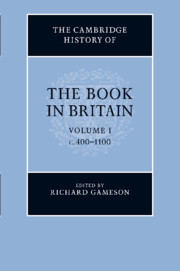Book contents
- Frontmatter
- 1 From Vindolanda to Domesday: the book in Britain from the Romans to the Normans
- PART I THE MAKING OF BOOKS
- PART II THE CIRCULATION OF BOOKS
- PART III TYPES OF BOOKS AND THEIR USES
- 15 The book in Roman Britain
- 16 The use of the book in Wales, c. 400–1100
- 17 The biblical manuscripts of Anglo-Saxon England
- 18 Anglo-Saxon gospel-books, c. 900–1066
- 19 Liturgical books
- 20 Anglo-Saxon prayerbooks
- 21 Psalters
- 22 Music books
- 23 Anglo-Saxon schoolbooks
- 24 Law books
- 25 Manuscripts of the Anglo-Saxon Chronicle
- 26 Old English homiliaries and poetic manuscripts
- PART IV COLLECTIONS OF BOOKS
- PART V CODA
- Bibliography
- Concordance of named manuscripts
- Index of manuscripts
- General Index
- Plate 4.1: The Lindisfarne Gospels"
- Plate 5.1: The Lichfield/St Chad Gospels"
16 - The use of the book in Wales, c. 400–1100
from PART III - TYPES OF BOOKS AND THEIR USES
Published online by Cambridge University Press: 28 March 2012
- Frontmatter
- 1 From Vindolanda to Domesday: the book in Britain from the Romans to the Normans
- PART I THE MAKING OF BOOKS
- PART II THE CIRCULATION OF BOOKS
- PART III TYPES OF BOOKS AND THEIR USES
- 15 The book in Roman Britain
- 16 The use of the book in Wales, c. 400–1100
- 17 The biblical manuscripts of Anglo-Saxon England
- 18 Anglo-Saxon gospel-books, c. 900–1066
- 19 Liturgical books
- 20 Anglo-Saxon prayerbooks
- 21 Psalters
- 22 Music books
- 23 Anglo-Saxon schoolbooks
- 24 Law books
- 25 Manuscripts of the Anglo-Saxon Chronicle
- 26 Old English homiliaries and poetic manuscripts
- PART IV COLLECTIONS OF BOOKS
- PART V CODA
- Bibliography
- Concordance of named manuscripts
- Index of manuscripts
- General Index
- Plate 4.1: The Lindisfarne Gospels"
- Plate 5.1: The Lichfield/St Chad Gospels"
Summary
The student of the book in early medieval Wales, and also in those other areas that remained British-speaking, labours under a modest handicap: there are no surviving books known to have been written in Wales or Cornwall before the ninth century. From the British-speaking kingdoms of northern Britain there survive no books at all. The history of the British book must, therefore, be written by circuitous processes of reasoning: by inference from texts written by Britons but only surviving in later and non-British manuscripts, from other modes of lettering, notably inscriptions on stone, and, finally, from comparison with Ireland. The comparison with Ireland is justified because it was part of the one Insular cultural province; not only did it have the same scripts, essentially the same orthography for Latin texts, the same methods of constructing a codex, but current practice usually evolved in the same direction and at much the same time. Moreover, in the early part of our period, there were Irish colonies in Britain, including Wales, and British missionaries in Ireland; even in a later period, there is ample evidence of continued scholarly and ecclesiastical links across the Irish Sea.
There are two fundamental reasons why the distribution of surviving manuscripts cannot be taken as an indication of the usage of books. First, to stick to a position so closely dependent upon one category of evidence would entail a lack of consideration for other categories of evidence, especially texts and inscriptions. Second, it would be to forget that, in general, pre-Norman Welsh manuscripts survived only if they were taken to England in the tenth century and were there preserved in ecclesiastical libraries. Similarly, it is broadly true that early Irish books survived only if they were taken to Francia or to Italy in the eighth or ninth centuries. English books survived somewhat better because they travelled along both routes to preservation – Francia in the eighth and ninth centuries and into the libraries of reformed English monasteries and cathedrals in the tenth century.
Keywords
- Type
- Chapter
- Information
- The Cambridge History of the Book in Britain , pp. 389 - 405Publisher: Cambridge University PressPrint publication year: 2011

